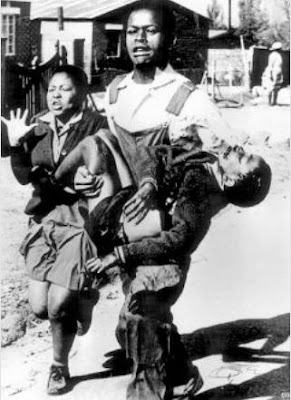Author: Sam Nzima.
Pretoria-South Africa.
It celebrates 35 years of protest where Zolile Hector died in Soweto. June 16, 1976.
are honoring him at photogs who helped expose the brutality of apartheid in the world with an image that ended his career.
on Wednesday celebrated the Day of Freedom in South Africa, to mark the anniversary of the country's first elections.
President Jacob Zuma national honors granted to Sam Nzima, who with his camera captured an image that went round the world have joined us reminecensia of Michelangelo's Pieta. Where we see death Zolile Hector Pieterson a teenager of only 13 years old by the police after being shot on 16 June 1976 in the Soweto uprising.
are honoring him at photogs who helped expose the brutality of apartheid in the world with an image that ended his career.
on Wednesday celebrated the Day of Freedom in South Africa, to mark the anniversary of the country's first elections.
President Jacob Zuma national honors granted to Sam Nzima, who with his camera captured an image that went round the world have joined us reminecensia of Michelangelo's Pieta. Where we see death Zolile Hector Pieterson a teenager of only 13 years old by the police after being shot on 16 June 1976 in the Soweto uprising.
Note: Mbuyisa Makhubo 18, carrying the young Hector Pieterson, walking with Hector's sister, Antoinette. Taken on June 16, 1976. Author: Sam Nzima
Nzima received the Order of Ikhamanga recognizing South Africans who excel in the arts, culture, literature, music, journalism and sport. Previous ganadodres were jazz legend Hugh Masekela and the novelist Alan Paton.
Nzima made manifest in an interview yesterday in which his photograph was seen around the world, "tells the story of what happened. You do not even need a title to see that something terrible has happened." Nzima
75, recalled the fury of the police prompted by the publication of the photograph, making it feared for his life. He left Johannesburg to become a businessman in a small town in eastern South Africa. Pieterson
was the first to die by gunfire from the police after it was ordered the dispersal of students by police in Soweto. The students were protesting the government order to the time of giving afrikaans. (Language of the white minority in South Africa)
killed hundreds of young people in conflict that is exacerbated in the 80 `s, he finally came to the demise of apartheid in the early 90` s.
Nzima who came to Soweto early in the morning in 1976, was intended to cover a peaceful demonstration of protest. His eyes and lens of his camera captured the image that the world was silent.
Nzima received the Order of Ikhamanga recognizing South Africans who excel in the arts, culture, literature, music, journalism and sport. Previous ganadodres were jazz legend Hugh Masekela and the novelist Alan Paton.
Nzima made manifest in an interview yesterday in which his photograph was seen around the world, "tells the story of what happened. You do not even need a title to see that something terrible has happened." Nzima
75, recalled the fury of the police prompted by the publication of the photograph, making it feared for his life. He left Johannesburg to become a businessman in a small town in eastern South Africa. Pieterson
was the first to die by gunfire from the police after it was ordered the dispersal of students by police in Soweto. The students were protesting the government order to the time of giving afrikaans. (Language of the white minority in South Africa)
killed hundreds of young people in conflict that is exacerbated in the 80 `s, he finally came to the demise of apartheid in the early 90` s.
Nzima who came to Soweto early in the morning in 1976, was intended to cover a peaceful demonstration of protest. His eyes and lens of his camera captured the image that the world was silent.
"One of them said, Afrikaans should be abolished"
Author: Sam Nzima.
"We are being fed by the crumbs of education"
"We are being fed by the crumbs of education"
The demonstrators were confronted by a white police officer who told them he would shoot if they did not disperse. Instead young people began chanting "Nkosi Sikelel 'iAfrika" (God Bless Africa)
"That song, which is the national anthem today, is then banned "Nzima said.
Nzima saw that the police started shooting, then I see a tall boy who picked up a teen who ran away. Nzima took six photos which captures the moment where he was taken to the nearest car
Author: Sam Nzima
When he worked as a photographer Nzima restrictions existed for reporting on the conflict, to avoid problems take off film of his camera and hidden in his underwear. Police later forced him to expose the film in his camera but Pierterson photos were safe
"Many people ask me why I could not help Hector Pieterson? Nzima said: "It was my duty. The journalist must do his job." My job is to take pictures. "
And this picture, made a difference.
" This picture was a revelation to the world whole "
Note: This post is a free translation of the original article.
Source: Donna Bryson (Associated Press) Yahoo News. Mr. Javier Diaz, ACSUN, Sam Nzima




0 comments:
Post a Comment